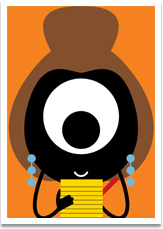Suzy Menkes discusses the pressure on today’s European princesses as they are judged through the camera lens
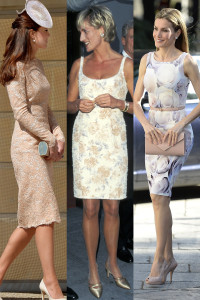
Left to right: Catherine, Duchess of Cambridge, at a Buckingham Palace garden party this month; Princess Diana in 1997, the year she died; Letizia of Spain attends her first solo engagement as Queen by visiting Madrid’s Prado Museum © getty images
Europe’s royal princesses are fixated on image
I gazed at the photo of the new Spanish Queen Letizia, sitting in a priestly white outfit next to her angelic daughters. And I felt like weeping.
My emotion was not at seeing the inauguration of King Felipe Vl. Nor was I interested in who had designed his wife’s outfit. Especially not that.
But I felt the same chagrin that I do for all this generation of European princesses, who are smart, intelligent, chosen for love, not their blue blood – yet destined to be seen as nothing but coathangers.
There is more chitchat about their clothes, their body shapes, their supposed nose jobs and other trivia than there is about the issues and causes that they have been working on for the last decade.
I blame Diana – although it is about her legacy, not her fault. The Princess of Wales did so much good work, from campaigning for treatment for AIDS, through the removal of mines, to helping children with leukemia, yet she was defined more by her charismatic persona than by her deeds. And especially by the way she looked and dressed.

Left: “Shy Di”, the Princess of Wales during a visit to Australia in 1985. Right: “confident divorcée” Diana attends the Vanity Fair party at London’s Serpentine Gallery in 1994. The famous black “revenge dress” was a spectacular coup by the princess, worn on the very evening that Prince Charles admitted to adultery on television © getty images
Diana, aristocratic, poorly educated and needy for love and support, was smart enough to use her clothes as a message board. The transformation of “Shy Di” into a young mother, a scorned wife, a confident divorcée and ultimately a superstar was deliberately played out in her appearance.
But the disastrous legacy of a caring and committed princess, who would have been a 53-year-old grandmother on July 1 this year, has been to lure the next generation of royal princesses towards the mirror. They have focused on appearance, something that Diana so brilliantly manipulated, following the siren call of the television screen and the newspaper picture. Their goal has become the impossible task of being a new Lady Di.
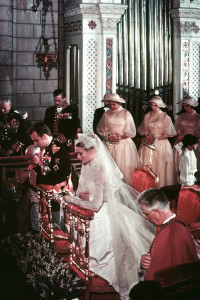
Princess Grace and Prince Rainier III of Monaco during their wedding ceremony in the principality’s Saint Nicholas Cathedral, 1956 © getty images
I watched the Grace of Monaco movie, panned by the critics, and realised that the concept of a royal princess as a movie star started with the real thing: Grace Kelly’s marriage to Rainier of Monaco in 1956. Back then, the presentation of majesty was a Hollywood vision in silk, diamonds and up-’dos that set the style standard of her time.
Today, the image is viewed through a smartphone lens. Letizia, visiting the Prado Museum in Madrid this week, in her first official role as Queen, looked super-slender. But seeing her in real life, as with Queen Rania of Jordan, is to view tiny little birds, dieted down to a silhouette made for TV.
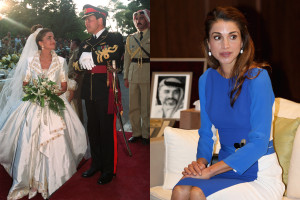
Left to right: Rania, who became Queen of Jordan in 1999, wearing a Bruce Oldfield gown for her wedding to Abdullah II at the Royal Palace in Amman in 1993; Rania’s polished look of today © getty images
Compare their current images to their royal wedding albums and everything seems to have changed: body shape, cheeks, nose. It is a case of young women, now just turned 40, re-modelling themselves for the relentless camera eye.
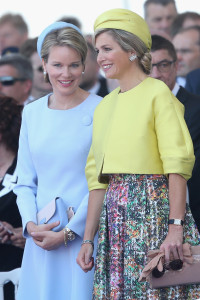
Queen Máxima of the Netherlands and Queen Mathilde of Belgium sit together during a ceremony earlier this month © getty images
All the current young royals – Mary of Denmark, Mette-Marit of Norway or the newly crowned Queen Máxima of the Netherlands – are slim and trim to different degrees. Stout royal figures are found only in the abdicating generation, like the pigeon plump former Queen Beatrix of the Netherlands, who has a similar silhouette to Britain’s late Queen Mother.
Kate Middleton is part of the new breed. She went from sporty student to skinny princess and now, after showing her baby bump at the birth of Prince George a year ago next month, is super-slim in photographs and pin-thin in real life.
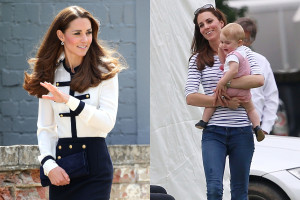
Left to right: the Duchess of Cambridge in a formal Alexander McQueen outfit earlier this month; and wearing jeans in a more relaxed style to watch Prince William play in a charity polo match © getty images
The Duchess of Cambridge is using her intelligence – like Prince William, she is a graduate of the University of St Andrews in Scotland – to create a persona through the language of clothes. Her high/lo dressing, in Alexander McQueen couture one day and off-the-peg Zara the next, sends out a message: “I can be royal – but I am still simple Kate.”
Some of the blame for the focus on clothes, rather than deeds, must lie with ourselves – fashion editors who are quick to criticise, egged on by a blogosphere of shrill, smartphone critics.
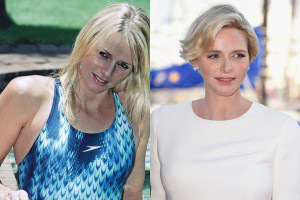
Left to right: Charlene Wittstock in 2006 as a South African swimmer prior to her 2011 marriage to Prince Albert II of Monaco; a pregnant Princess Charlene of Monaco in Monte Carlo earlier this month © getty images
Although we know that all the princesses, from South African swimming supremo Charlene of Monaco through the Tasmanian born Mary of Denmark to the aristocratic new Belgian Queen Mathilde, all have had causes that they support, it is far easier to comment on their wardrobes than their deeds.
Letizia, for example, is involved in various charities: research into rare diseases or support for the World Health Organisation’s nutrition programmes. Charlene of Monaco champions children’s causes and water-safety charities. Mary of Denmark is patron of the Danish Cancer Foundation and studies of rare disorders.
Maybe in their own countries these projects are widely known. But globally, the only comments that stick are Karl Lagerfeld’s remark that Kate could have been Mary’s younger sister.
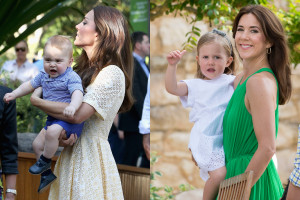
Kate Middleton, holding her son and heir to the throne, Prince George, and Mary of Denmark, with daughter Princess Josephine, both have a similar approach to their royal appearance © getty images
What else is in the news? There have been endless questions about when Charlene and Albert of Monaco would start a family. That chatter has now morphed into whether Charlene is expecting twins.
Ah, motherhood! The anachronistic part of modern monarchy is that it is still the destiny and the purpose of a princess who marries into a royal family – as it has been since ancient history – to have a child or two. She is required to produce “an heir and a spare” that guarantees a royal succession.
Yet that is not enough in a world of selfies and Instagram. Once she has produced a child, a princess feels that she has to wave a magic wand to recover after pregnancy her former silhouette – just like the Hollywood stars. Staying skinny for the camera has become an obsession.
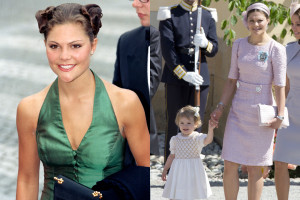
Left to right: a young Crown Princess Victoria of Sweden in 1997 and as a mother with daughter Princess Estelle this month © getty images
The only royal figure to admit to an actual eating disorder (apart from Diana and her bulimia) is Crown Princess Victoria of Sweden, who suffered in 1997 from anorexia but now looks a healthy young mother. Significantly, perhaps, she herself is heir to the throne, not married into a royal family.
Gossip has claimed that Letizia is anorexic. And her present light-as-a-bird look is very different from the powerful television presenter Letizia Ortiz Rocasolano before her marriage in 2004.
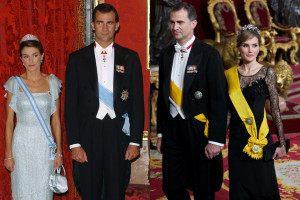
Left: Letizia as Princess of Spain in 2004, the year she married King Felipe Vl; and right, a few days before she became Queen of Spain © getty images
Colombe Pringle, for 10 years editor-in-chief of French royal and society magazine Point de Vue, followed the new princesses and saw the dramatic changes.
I asked her why the younger royals became obsessed by their appearances.
“They all want to be movie stars – and they realised that photographs can make you look fat,” said Colombe, who is currently a French television journalist.
In Pringle’s view, the young royals find themselves part of a wider societal change.
“It’s the first generation for everyone,” she says. “It’s the first time magazines only talk about ‘It’ bags. That Cannes is all about the red carpet. These girls are like coathangers with diamonds in their ears.”
Pringle, who made the magazine more intelligent and more political than a traditional royalty publication, saw Carla Bruni morph from being France’s First Lady to a walking advertisement for Bulgari jewels.
Colombe even admits that Kate Middleton’s mane of hair looks to her more like an advertisement for Head & Shoulders shampoo than a royal ”do”.
So what is the future of these middle-class princesses without the blood royal pulsing through their veins?
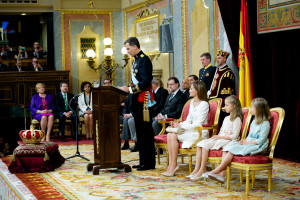
Leonor, Princess of Asturias, direct heir to the throne, in pink, and her sister Princess Sofia, in blue, sit with their mother to watch as their father is inaugurated as King of Spain © getty images
The great, historical change is that the firstborn child – female or male – is now in line for the throne, since the rules of primogeniture in royal succession were amended.
And by happy chance, apart from Prince George, almost all the princesses have produced girls as firstborns. So the Infanta Leonor of Spain, now just eight years old, will be a queen one day in her own right, along with Princess Estelle of Sweden, Ingrid of Norway, daughter of Crown Princess Mette-Marit, or Catharina-Amalia, daughter of Queen Máxima of the Netherlands.
Does that mean that a new group of little girls will grow up to be confident princess royals and ultimately queens known for what they do – not how they look?
Now that would be a real royal fairytale.
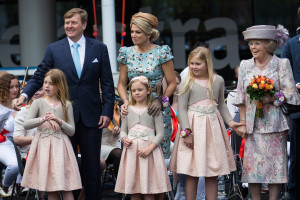
Left to right: Princess Alexia, Princess Ariane and their elder sister and direct heir to the throne Princess Catharina-Amalia of The Netherlands stand under the watchful gaze of their parents King Willem-Alexander, Queen Máxima of The Netherlands, and their grandmother, the former Queen Beatrix © getty images

